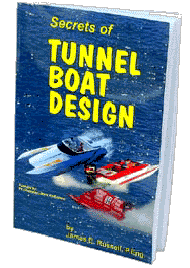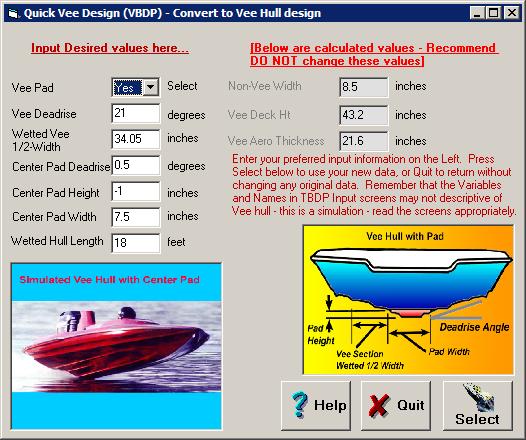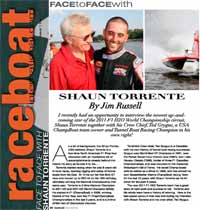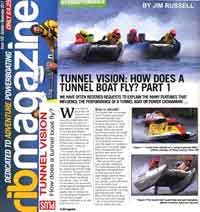
~~~~~~~~~~~~~~~~~~~~~~~~~~~~~~~~~~~~~~~~~~~~~~~~~~~~~~~~
TBPNews #144 - Sept 27 2011
~~~~~~~~~~~~~~~~~~~~~~~~~~~~~~~~~~~~~~~~~~~~~~~~~~~~~~~~
>>>> Tunnel Boat Performance News
>>>>>> (over 5000
members!)
========================================================
In this issue:
1)
Ziggy & Charlie Strang Elected To 2011 UIM F1 Hall Of Fame
2) Oberto breezes to Seafair Unlimited victory
4) FEATURE: "Why Does My Boat Porpoise?"
5) P1 SuperStock champions crowned in Liverpool
6) "Secrets of Tunnel Boat Design" book & TBDP/VBDP V7.13 software!
8) Jimboat's NEW Feature Articles
******************** TBPNews
*******************
Check out review
of Jimboat's 13th Ed. "Secrets of Tunnel Boat Design" book in the last HotBoat
magazine printed!
1) Ziggy & Charlie Strang Elected To 2011 UIM F1 Hall Of Fame
 ABU DHABI – In the closest, most tense voting tallies in the history of the UIM F1 H2O World Championship “Hall of Fame” election, two pillars of the sport of power boat racing, Siegfried “Ziggy” Boettle and Charlie Strang, were officially elected into the sports 2011 “ring of honor”.
ABU DHABI – In the closest, most tense voting tallies in the history of the UIM F1 H2O World Championship “Hall of Fame” election, two pillars of the sport of power boat racing, Siegfried “Ziggy” Boettle and Charlie Strang, were officially elected into the sports 2011 “ring of honor”.
The election, was open to race fans around the world having an opportunity to vote on the official website at www.f1h2o.com with the final results giving Ziggy Boettle a 42% tally easily the top vote getter while the battle for the final spot for the Hall of Fame going right down to the final day with Charlie just out-dueling Germany’s Michael Werner by one percentage point. Ziggy and Charlie will join the likes of Renato Molinari, William Seebold, Scott Gillman and Fred Hauenstein Jr. into the history books and will forever be part of the “Hall of Fame” family.
Ziggy, who was one of top engineers for Outboard Marine Corporation (OMC) for over 40 years, devoted his time to the sport of power boat racing for over three decades be it from local levels in the Chicago area to the international UIM community. In 1996 he became the UIM F1 H2O Technical Commissioner regarding the legalities of all racing drivers throughout a Grand Prix weekend in all aspects of equipment and race engines. The Gurnee, Illinois resident has served many years with the UIM International Governing body and is currently head of the “Safety Cockpit Committee” on the F1 Committee roundtable as well.
Charlie Strang is one of living legends of the sport. He developed and designed the concept and later started the UIM F1 World Championship for OMC back in 1981. Charlie fell in love with the sport of boat racing after attending the New York Boat Show when he was young. He started racing in 1937 at the age of 14. After serving for the Army Air Corp in World War II Charlie was involved with early jet aircraft engineering. He taught his theories at the Massachusetts Institute of Technology (MIT) while still being drawn to his first passion of boat racing. This interest eventually steered him over to the business side of the sport and went to work for Carl Kiekhaefer at Mercury Marine. Later making the move to rival OMC. Charlie has served as President of the APBA (American Powerboat Association) and is currently the Senior Vice President of the USA for the Executive Committee of the UIM. Charlie has received the UIM “Medal of Honor” and the “American Success Award” from ex-President Bush.
Both men are truly deserving of this honor as both visionaries and pioneers of the most exciting and thrilling sport on water, the UIM F1 H2O World Championship for power boating.
Check out more at: f1h2o.com
******************* TBPNews ******************* [return to top]
2) Oberto breezes to Seafair Unlimited victory
 Steve David figured he had one shot -- or should that be a pass - to beat Dave Villwock and the Spirit of Qatar in the winner-take-all final heat of the Albert Lee Cup at Seafair.
On this day, the prayer was answered as David won his gamble at the start, then held off Villwock to win Seafair for the second straight year. Villwock finished third, behind Scott Liddycoat and the U-7 Valken.com.
Steve David figured he had one shot -- or should that be a pass - to beat Dave Villwock and the Spirit of Qatar in the winner-take-all final heat of the Albert Lee Cup at Seafair.
On this day, the prayer was answered as David won his gamble at the start, then held off Villwock to win Seafair for the second straight year. Villwock finished third, behind Scott Liddycoat and the U-7 Valken.com.
David's starting gamble was devised in consult with other team members before the final heat as they came up with a strategy that caught their competitors off-guard. With drivers allowed to fight for their lanes instead of having them pre-arranged, many pilots all day had decided to slow to a crawl as they got close to the one-minute buoy, attempting to take the inside lane by parking in it. Four drivers did that for the final, including Villwock. David, instead, sped around the "trollers" on the outside and hit the line at close to full speed. Once safely ahead, the rules then allowed him to cut inside and take lane one since he was able to get it.
David said his plan was to "hit the entry pin at the 66-second mark wide open while they are still putt-putting. The moment I hit the one-minute (mark) I dive inside while they are still trying to figure it all out."
David now has 14 career wins, nine coming since the Oberto built its new hull in 2007. There was some good early racing in preliminary heats -- all free of major incident -- but nothing to dissuade the notion the final would come down to David and Villwock.
The top three finishers: U-1 Oh Boy! Oberto David 136.283 mph; 2 U-7 Valken.com Liddycoat 134.547 mph; 3 U-96 Spirit of Qatar Villwock 131.356 mph.
Check out more at tri-cityherald.com
******************* TBPNews ******************* [return to top]
 Check
out these great videos....
Check
out these great videos....
......STV high speed runs
.......Racing on Lake Como, Italy - the Centomiglia del Lario
4) FEATURE: "Why Does My Boat Porpoise?"
Questions from subscribers: 1) "My ModVP style sport tunnel (with centerpod) has a real "hopping" motion at about 70 mph. It's like a porpoising, but it goes away at about 80mph. What is wrong with my setup?"; OR 2) "I have a Checkmate 24 that porpoises at one speed and won't stop - why is this?
Answer: Porpoising is common in many hull designs, and is a common trait of high-performance hulls - particularly tunnel hulls and pad-vee designed hulls. I call this transition speed the "hump zone", and it often marks the onset of porpoising.
 Any vee hull or tunnel hull can be susceptible to porpoising, depending on design and setup. For example, flatter bottom vees are more prone to porpoising than steeper deadrise vee hulls, but there are several contributors to the occurrence and any hull can find the problem caused by dynamic instability.
Any vee hull or tunnel hull can be susceptible to porpoising, depending on design and setup. For example, flatter bottom vees are more prone to porpoising than steeper deadrise vee hulls, but there are several contributors to the occurrence and any hull can find the problem caused by dynamic instability.
The "bouncing" or porpoising comes from a rapid change in the location of the center of Lift (CofL) as the boat accelerates. The relocation of static weights is one way of dampening the rate of change of the CofL...so it's not always obvious whether to move weight fore or aft in order to cause the "dampening". The solution can be calculated, but it's also not too difficult for you to find out through testing, whether moving weight fore or aft will help your particular problem.
The resolution to a porpoising problem with a hull design is most always addressed by causing the boat to run with less trim. There are many different ways of achieving this. More on this, later.
 What Causes the Onset of Porpoising? - A tunnel hull
gains it's performance from a unique balance between aerodynamic lift generated
by the aerofoil/tunnel configuration and the hydrodynamic lift generated by the
running pads (on the water). It's "hump" or "transition zone"
represents the speed at which the amount of lift
becomes predominantly aerodynamic (air lift from tunnel and aerofoil) compared
to hydrodynamic (water lift from sponsons). On a pad-Vee hull, the "hump zone" is the speed at which the amount of lift changes from mostly the vee surfaces to mostly lift from the pad surfaces.
What Causes the Onset of Porpoising? - A tunnel hull
gains it's performance from a unique balance between aerodynamic lift generated
by the aerofoil/tunnel configuration and the hydrodynamic lift generated by the
running pads (on the water). It's "hump" or "transition zone"
represents the speed at which the amount of lift
becomes predominantly aerodynamic (air lift from tunnel and aerofoil) compared
to hydrodynamic (water lift from sponsons). On a pad-Vee hull, the "hump zone" is the speed at which the amount of lift changes from mostly the vee surfaces to mostly lift from the pad surfaces.
At the speed that the transition occurs, the hull will always experience some longitudinal instability - like porpoising (but not always in that form). The hull experiences a dynamic CofG shift through the "hump" zone. The transition velocity can be accurately determined for any given hull design and setup, and can even be altered by hull design, weight distribution, propeller selection and engine/hull setup. Engine height adjustment can help find the best setup to "smooth out" the transition. Sometimes unplanned 'hook' or 'rocker' in the running pad surfaces can exaggerate the performance effects thru the "hump zone". Weight movement will also change the speed at which the "hump zone" occurs.
 The best performance hull designs minimize the
"hump zone" to one that is very mild and through a narrow velocity
range. This balance is usually maximized at the initial design stage. Once boat is
designed/built, the best solution is to setup so that the hump zone
occurs at a velocity that the driver does not need/intend to spend time in...in
other words, you are just "passing through". Setup, trim and weight
balance can help this allot.
The best performance hull designs minimize the
"hump zone" to one that is very mild and through a narrow velocity
range. This balance is usually maximized at the initial design stage. Once boat is
designed/built, the best solution is to setup so that the hump zone
occurs at a velocity that the driver does not need/intend to spend time in...in
other words, you are just "passing through". Setup, trim and weight
balance can help this allot.
The boat's reaction as it goes thru the hump zone (for a given design/setup) will always be the same, too. So driving/handling experience helps. The "effects" of the hump zone can be "softened" through design and setup changes, but will always be there. There are design and setup optimizations that can be made to make the "hump zone" as smooth as possible - even comfortable - but you will always have to "drive-through" the hump zone, in one way or another. The more 'seat-time' in the boat - the more experience there is in knowing how your setup behaves as it passes through the transition.
[The detailed engineering analysis of "porpoising" is somewhat complex, but is also addressed here. (http://www.aeromarineresearch.com/tbdp6/porpoise.html)]
So, What Do I Do About It? -
Porpoising is a function of the lift generated by your hull, the deadrise of your running surfaces, and the trim angle that is needed to get that lift. The onset of porpoising is, in part, influenced by the weight balance in the boat. Altering the deadweights in your boat (fuel, payloads, etc) can affect the speed and trim angle that porpoising will initiate. If a boat is porpoising at a given speed and load, lowering the trim angle will reduce or eliminate the porpoising. There are several ways to get there, but the bottom line is to reduce trim at the velocity of porpoising onset. (Higher deadrise hulls are less susceptible to porpoising.) Even if the hull design is operating in the "Porpoising Regime" through a full range of velocities, reducing trim in some way will improve or resolve the problem.
For your hull design and setup, the speed and trim angle at which you will see the onset of porpoising can be determined. Changing trim angle, changing motor height, changing propellers, moving weight forward, will all help to reduce porpoising at a given velocity. Changing design variables such as running surfaces design, deadrise, engine setback, etc. can help maintain the hull in stable planing regime, avoiding porpoise regime.
Propeller selection can often change the dynamic balance of the hull/setup. For example, a change to a prop that provides more aft-Lift can alter the dynamic balance of the hull, and similarly change the speed and range of the "hump zone" – often eliminating porpoising. Weight distribution changes can also have a positive effect on "where" the "hump zone" will occur, as can change in power application. Changing "trim" angle while driving through the "hump zone" even if less efficient, will also provide a better experience, and when well controlled, can "close up" the range of "hump zone" substantially – eliminating porpoising.
Trim tabs (or more extreme whale fins) will also improve a porpoising problem, but these will also affect overall performance of the hull. Adding transom wedges can often help too, since they will allow for more negative trim travel, if it's required. Raising the prop shaft higher will shift CofG forward and reduce trim angle. More HP also reduces trim angle. Reducing your trim angle in some way will always help a porpoising problem.
/Jimboat
Read more on Porpoising in this article on "Hump Zone/Why does my Boat Porpoise?".
Read more about Tunnel Boat & performance boat design and setup in the world acclaimed "Secrets
of Tunnel Boat Design" book
See more Performance Articles at: http://www.aeromarineresearch.com/articles.html
[Note: Do you have any of your own questions on performance hull design? Send your question or story to Jimboat@aeromarineresearch.com ]
******************* TBPNews ******************* [return to top]
5) P1 SuperStock champions crowned in Liverpool
 John Wilson (Coleshill, Birmingham) and Neil Scarborough (Monks Risborough) were crowned 2011 P1 SuperStock 250 Champions at the final round of the five-race series.
John Wilson (Coleshill, Birmingham) and Neil Scarborough (Monks Risborough) were crowned 2011 P1 SuperStock 250 Champions at the final round of the five-race series.
The Pertemps crew won British powerboat racing’s biggest title by four points from closest rivals Peters & May, driven by Darren Hook (Wadhurst) and navigator David Harwood (Wimbledon), with Rookie team Simon Bayles (Battersea) and Philippa Baker (Kensington) finishing third to cap an amazing first ever season of racing.
Three outright race wins, three podium finishes plus fourth place last time out in Cowes were enough to win Wilson and Scarborough’s second consecutive SuperStock title, as the duo won last year’s P1 150 Class.
New SuperStock race boat and championship - Powerboat P1 has launched a new race boat, P1 Panther 28SS to revolutionise the sport of mono-hull racing. Its design features the latest technology in safety, hull design, digital telemetry and data acquisition. The P1 Panther debuts in SuperStock national championships in the UK and USA this summer. The advent of the P1 Panther class will create a new, wider base to the pyramid for racers and as it spreads worldwide, a new route to the top of the sport. SuperStock UK 2011 has two classes: P1 Panther 250 for the new 28’ racer, powered by identical Evinrude 250 High Output engines plus the 150 category for smaller 21ft ‘sports cruisers' with identical 150hp Honda engines.
See more at: bymnews.com and powerboatp1.com
******************* TBPNews ******************* [return to top]
6) "Secrets of Tunnel Boat Design" book & TBDP/VBDP V7.13 software!
 TBDP/VBDP© -
BIG NEW FEATURES...YOU ASKED FOR IT...NOW TBDP© HAS IT!....
TBDP/VBDP© -
BIG NEW FEATURES...YOU ASKED FOR IT...NOW TBDP© HAS IT!....
*** Full Vee Hull and Vee-Pad hull performance analysis (included in one software package!)
*** New aerodynamic algorithms.
*** Porpoise Analysis - We have developed a new analysis tool! XPorpoise is an
engineering tool developed by AR that predicts your hull's inherent
susceptibility to porpoising...and shows how to fix it!
*** User Picture import - right onto your TBDP© data input screen!
*** OEM Motor database, with over 960 OEM engine specs!
*** Centerpod Wangle input - now you have the ability to represent a special trim angle of the hull CenterPod that is different than the angle of
the Sponsons.
 *** NEW USER picture import feature.
*** NEW USER picture import feature.
*** New CG import feature.
*** Dozens of NEW features - including VEE HULL DESIGN software INCLUDED.
*** NEW - Now can select Inside Spray Rails or Outer Spray Rails or BOTH. NOW input measured Static CG of boat hull if desired (otherwise TBDP© will calculate for you).
*** NEW - 'Rate-of-Change' performance analysis!
*** Free Expert Analysis Reports (4) included shows how you can apply expertise
to your design/setup.
...AND Lots more new great Features in V7.13 TBDP© software!
...check out the new TBDP© software V7.13 at:
aeromarineresearch.com
******************* TBPNews ******************* [return to top]
7) Powerboat Racing on TV
*** "Thrill Zone: Extreme
Powerboats" -
National Geographic powerboat show.
 Author Jim Russell (Jimboat) is powerboat design technical consultant on a new
National Geographic special for "Thrill Zone"
series...
Author Jim Russell (Jimboat) is powerboat design technical consultant on a new
National Geographic special for "Thrill Zone"
series...
Details at: (channel.nationalgeographic.com)
check out more at
AR's website! aeromarineresearch.com/NatGeo_thrill-zone.html
*** "Powerboat SuperLeague" Series - Check out show schedule at AmericaOne.com
*** "IHBA Lucas Oil Drag Boat Racing"
Series on SPEED TV - Check next show at
speedtv.com
*** "War On Water" TV
Show" on
The Water Channel - Check it out at: www.waterchannel.com;
*** "Boats on TV" - See at: www.boatson.tv
*** "American Powerboat
Television" on The Water Channel - See: americanpowerboat.tv
*** "Honda Formula 4-Stroke Powerboat Series"
-
Check
it out at:
www.f4sa.co.uk
******************* TBPNews ******************* [return to top]

 NEW!
Jimboat details 'How a RIB tunnel hull Flies' (RIB magazine Oct/Nov 2011 issue)
NEW!
Jimboat details 'How a RIB tunnel hull Flies' (RIB magazine Oct/Nov 2011 issue)
Jimboat interviews the newest up-and-coming star of 2011 F1 H20 World Championship circuit, Shaun Torrente together with his Crew Chief Ted Gryguc.
Jimboat details the speed secrets of 'Vee pad design', vee hull design and
performance powerboat design
Jimboat explains 'Gearcase & Propeller BlowOut' (RIB magazine April 2011 issue)
Jimboat explains 'How Trim Angle and engine height affects performance' (RIB magazine Jan 2011 issue)
Jimboat explains 'Chine Walking' (RIB magazine Dec 2010 issue)
[Jimboat writes Feature articles in HotBoat, Family&Performance Boating, Performance Powerboat, RIB magazine, World of Powerboats, RaceBoat International, SEA Yachting, RIB magazine, Extreme Boats magazines].
-
Tunnel
Vision - 'How Do Tunnel Boats Fly?' - HB Nov/Dec 2008
- 'Why
Do Boats Create Rooster Tails?' -
HB-August 2008
- 'What
a Blow Out!' - "Gearcase & Propeller Blowout- Why it Happens & How to Fix it" -
HB-June 2008
-
'Walk on the
Wild Side' - "Chine Walk - Why it happens & How to Fix it" - HB-Jan
2008
- 'Hump
Zone' - "Why does your Boat Porpoise?" - HB-April 2007
-
'The Bottom Line'-"Why does a
Pad make a Vee Hull faster?" -
F&PB-Sept 2005
- "10
Smokin' Speed Secrets Revealed..." -
HB-Feb2005
-
"Winterizing your Performance Outboard" - F&PB-Jan2005
-
"What a Drag" - 'Trim Angle & Engine Height Can Reduce Drag and
Increase Speed' - HB-Sept2004
-
"10 Safety Tips" - 'Ten Safety Ideas for High Performance Go-Fast
Boats' - HB-Aug2004
- "Flight
Path" - 'Where does Lift Come From?' - HB-April2004
- "Rocket
Science" - 'How To Increase Your Hull's Design Speed With Aerodynamics' -
World of Powerboats-Winter2004
-
"Tunnel
Vision" - 'What Factors Influence Tunnel Hull Performance' - Extreme
Boats-April2003
- "Step-by-Step"
-
'Step
Design in Powerboats' - TBPNews #88, October 2005
******************* TBPNews
*******************
[return to top]
See you next time!
/Jimboat
>>>>>>>>>>>>>>>>>>>>>
Let us know ideas you have, requests for articles, questions or comments on TBPNews. Send
comments to TBPNews@aeromarineresearch.com
>>>>>>>>>>>>>>>>>>>>>>>>>>>>>>>>>>>>>>>>>>>>>>>>>
 Get your full, illustrated,
13th
edition copy of the world acclaimed "Secrets
of Tunnel Boat Design" book;
Get your full, illustrated,
13th
edition copy of the world acclaimed "Secrets
of Tunnel Boat Design" book;
"History
of Tunnel Boat Design" book, "Secrets
of Propeller Design" book, the "Tunnel
Boat Design" software
for tunnel and high-performance Vee-hull design,
and "PropWorks2"
software for speed prediction and propeller
selection at the AeroMarine
Research web site: http://www.aeromarineresearch.com